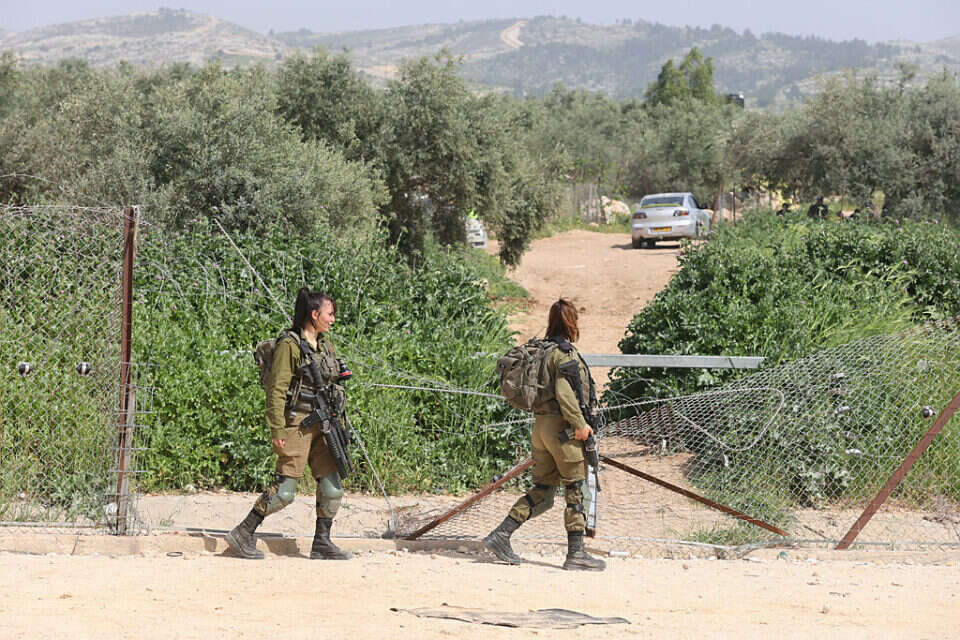Ignorance by the cabinet and actions by the central command without approval from above by the Ministry of Defense led the separation fence to neglect which in turn led to murderous attacks in Israeli cities, so states the State Comptroller's report. Even today, after hundreds of millions have been invested in renovating the fence, the comptroller warns that the phenomenon of infiltration through the
fence still exists, and so do the attempts to sabotage it. In the absence of a complete plan that would regulate the entire seam line, the citizens of Israel are still in danger - states the auditor.
Security fence.
"A series of omissions led to the fact that the seam was breached and allowed the terrorists to enter", photo: Dodo Greenspan
The State Comptroller examined the seam area at one of the country's most important junctions in recent years - in the period before the March-April 2022 attacks in Beer Sheva, Hadera, Tel Aviv and Bnei Brak, and immediately after.
Between the months of September 2021 and July 2022, three months into the "Breakwater" operation, the state comptroller's office conducted an audit on the effectiveness of the operational and operational response to the seam barrier, and revealed that the writing was on the wall.
The auditor's inspection reveals that a series of omissions and a lack of communication between ministries and organizations led to the fact that the seam was breached and allowed the entry of the terrorists to carry out the attacks.
Due to the great sensitivity of the report, only some of them are allowed to be published by the censors.
1.4 million Shebaim crossed the fence from 2021
As of the end of 2021, close to half of the length of the seam line fence was unfit or only partially fit - which allowed for infiltration without warning.
In 2021, approximately 1.4 million Sheba crossed the breached separation fence into Israeli cities, at the breached weak points in the Ephraim and Menasha sectors.
Four years earlier, it was decided by the Central Command that the repair of the recurring damage to the seam fence should be stopped, this without an orderly process aimed at examining the expected effects of reducing the repairs, and without the decision being brought to a discussion before the Minister of Defense and his approval.
"The IDF's decision to stop repairing the loopholes led to a continuous deterioration in the barrier's ability, which means the abandonment of the seam line barrier and the loss of governance in the area, and this without finding another solution to prevent infiltration into Israeli territory," the report states.
Although the loosening of defenses in the Seam area was presented to the decision-makers in the Ministry of Defense, to the Prime Minister and to the Cabinet from 2017 onwards, the Cabinet did not discuss actions to improve the effectiveness of the barrier until the attacks of March-April 2022. This, along with the reduction of the forces assigned by the IDF to the activity In the seam area, they led to "undermining the awareness of the fence and governance in the seam area sector and increasing the security risk, and in practice this risk materialized over the years, and especially in 2022", as defined by the State Comptroller.
"The IDF's decision to stop repairing the loopholes has led to a continuous deterioration." State Comptroller Matanyahu Engelman, photo: Oren Ben Hakon
Following the attacks, it was decided to allocate a budget of 360 million shekels in order to build a wall to replace the 40 km long section of the fence in the Menashe sector, this out of the cost of building a wall along the entire seam line which is estimated at about 2.4 billion shekels in total. "This investment may indeed reduce the phenomenon of infiltration in a certain segment, but in the absence of a complete and comprehensive plan there is a fear that the phenomenon of infiltration will continue, about the risk posed in the garden."
Large parts of the fence outside the observation systems
Although there is an improvement in the defense situation of the seam area, the State Comptroller warns that there are failures that could pose a serious security risk to the citizens of Israel.
"The collection system, which serves as an important component of the operational response in the seam area, is deficient," the auditor's report states. For example, a significant part of the seam line obstacle area is not observed by the existing observation systems. In addition, there is a significant shortage of between 10 and 25 percent in the number The observant, something that harms the IDF's ability to deal with the phenomenon of infiltrators.
The auditor warns that even the considerable reinforcement in the area of the seam did not result in the prevention of infiltration into Israeli territory in an optimal way.
Among other things, it says, about 100 breaches per day continue to occur in the fence on average, breaches that are repaired within a day.
"The IDF forces that are increasing the area of the seam line from May 2022 and securing the gaps in the fence, are staying in temporary and unregulated guard posts, in a way that is not adapted to the conditions of the field and for a long-term stay of several months," it added.
Not the perfect solution to say the least.
IDF soldiers block the gaps in the fence with their bodies, photo: Yonatan Shaul
In his concluding recommendations, the auditor writes that a long-term response and operational concept must be formulated that will provide protection for the seam area and Israel's homeland, to be formulated by members of the security establishment, the Ministry of National Security, the Ministry of Justice and the Ministry of Finance, and approved by the Prime Minister and the Minister of Defense. It was also recommended that The ombudsman will examine the policy of enforcement and prosecution against the infiltrators in order to deal with them.
IDF spokesman: "Criticism that does not represent reality in the last year"
An IDF spokesperson stated in response that "this is a criticism that does not represent the reality of the past year along the seam line.
Today, up to a few dozens of infiltrators pass through the seam area in Judea and Samaria a day.
The activity of the security forces prior to the 'Breaking Wave' operation was adjusted to the operational need.
With the start of the 'Breakwater' operation, it was decided to change the priorities and invest significant resources in the seam area in order to close the breaches in the fence.
Gaps and tears in the separation fence near Beit Lykia in southern Samaria, photo: Yonatan Shaul
"The efforts are reflected in placing many forces at the seam, improving the infrastructure of the fence, upgrading and placing technological measures at the seam, carrying out tailored training for IDF forces for operational employment at the seam, expanding the basket of legal tools against infiltrators who violate the law, strengthening cooperation between the security organizations against the phenomenon And additional efforts are being carried out along the seam line in order to prevent the passage of illegal infiltrators into the territories of the State of Israel."
Ministry of Defense: Contrary to the report, there was no decrease in fence repairs, but the opposite
The Ministry of Defense stated in response: "The data of the security system, which was transferred to the State Comptroller's Office, contradicts the data published in the audit report.
The defense system has invested NIS 8.3 billion in the seam area in the last 20 years.
The vast majority of the investment exists and is maintained to this day and includes walls, roads, camps, crossings, technologies, security guards, and more. The amount "lost" due to the breaches is estimated at only 32 million shekels over approximately 20 years of maintaining the fence and repairing breaches. For over a year the security fence is 100% in order and is repaired every day.
"Prior to the security escalation and the 'Breakwater' operation, the serviceability of the seam fence stood at approximately 82%, except in the areas where it was operationally decided not to repair the breaches. As you can see, within two weeks of the start of the operation, the Border Directorate closed and stitched the entire barrier and it stands, as mentioned, at 100% Service since then.
"The Directorate of Borders and Seas has carried out maintenance operations and repair of loopholes over the years. For security reasons, it was decided not to repair the loopholes only in recurrent damage centers, which make up about 18% of the total barrier. The full maintenance reports were presented to the State Comptroller.
"Contrary to what was claimed in the report, there was no decrease in fence repairs, but the opposite.
In the years 2020-2022, 4,371 repairs were carried out, an increase of 100% compared to the years 2017-2019, in which 2,287 repairs were carried out.
In a multi-year perspective, the current maintenance activity saved about NIS 9 billion in the last decade.
The decision of the Ministry of Defense to maintain an existing operational system and not to launch a new tender saved the defense system about a billion shekels.
"The system continues to provide operational output even after 20 years since it was established and even though its life span was originally defined as only 15 years. Despite what is written in the report, in the years preceding the report, the observation systems at the obstacle were replaced with modern and advanced systems. As part of the 'Breakwater' operation, a plan to strengthen the endless defense was approved in the space in the seam, which is carried out these days.
The seam line in Kfar Salem.
The Ministry of Defense claims that there was no decrease in fence repairs, photo: Gil Eliyahu-Gini
"The Border and Sea Authority is rebuilding the barrier in northern Samaria, between Salem and Ornit. The barrier, which will include a wall in part and a reinforced fence (hourglass) with technological measures and new collection sites, will be completed within about a year. The Ministry of Defense is currently formulating a plan to upgrade the barrier and the crossings along it. The plan will be brought for the approval of the political level".
were we wrong
We will fix it!
If you found an error in the article, we would appreciate it if you shared it with us













